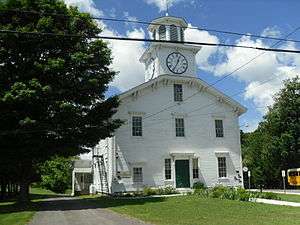Peterboro, New York
Peterboro, New York, located about twenty-five miles southeast of Syracuse, is an historic hamlet and current administrative center for the Town of Smithfield, Madison County, New York. The National Abolition Hall of Fame and Museum is located at the former Smithfield Presbyterian Church, in Peterboro. Peterboro has a post office with ZIP code 13134.[2]
Peterboro, New York | |
|---|---|
Hamlet | |
%3B_Siloam_(Village)%3B_Peterboro_(Village)%3B_Town_of_Smithfield_Business_Notices.%3B_Peterboro_Business_Notices._NYPL1584266.tiff.jpg) 1875 map | |
 Peterboro, New York  Peterboro, New York | |
| Coordinates: 42°58′00″N 75°41′10″W | |
| Country | United States |
| State | New York |
| County | Madison |
| Town | Smithfield |
| Elevation | 1,296 ft (395 m) |
| Time zone | UTC-5 (Eastern (EST)) |
| • Summer (DST) | UTC-4 (EDT) |
| ZIP code | 13134 |
| Area code(s) | 315 & 680 |
| GNIS feature ID | 960231[1] |

Founding
In 1795, Peter Smith, Sr., a partner of John Jacob Astor's who built his fortune in the fur trade, founded Peterborough, naming the town after himself. Smith moved his family to Peterborough in 1804 and built the family home there. In 1894 the town name was changed to Peterboro, which is the form it retains to this day.
Notable residents
Gerrit Smith
In the 1820s, Gerrit Smith took over the business interests of his father, Peter Smith, Sr., managing his family's property holdings in the town and the surrounding area. The Peterboro Land Office was built as the office for these activities.
Gerrit Smith's commitment to both the abolition and temperance movements led to the Smith estate in Peterboro becoming a stop on the underground railroad and to Smith building one of the first temperance hotels in the country in Peterboro. The Smith estate also served as an important meeting place for abolitionists from both New York and other parts of the country, including John Brown and Frederick Douglass.
Others
- Elizabeth Cady Stanton, a founder of the women's rights movement and cousin of Gerrit Smith's on his mother's side, met her husband, Henry B. Stanton, at the Smith home in 1839.
- George Pack, his wife Maria Lathrop, and family resided in Peterboro in the late 1830s and early 1840s. From Peterboro, Pack went on to Michigan's Lower Peninsula where he founded the family's business interests in timber.[3] Pack's son, George Willis Pack, who was born in Peterboro, and grandson, Charles Lathrop Pack, both became well-known timbermen in their own right.
- Alexander Preston Ellinwood, Wisconsin politician, teacher, and businessman, was born in Peterboro.[4]
Historic sites
In 2001, the Gerrit Smith Estate was designated a National Historic Landmark. The Peterboro Land Office building and Smithfield Presbyterian Church are listed on the National Register of Historic Places.[5]
References
Notes
- "Peterboro". Geographic Names Information System. United States Geological Survey.
- United States Postal Service. "USPS - Look Up a ZIP Code". Retrieved October 12, 2017.
- Eyle, p. 2
- 'Wisconsin Blue Book 1879,' Biographical Sketch of Alexander Preston Ellinwood, pg. 504
- "National Register Information System". National Register of Historic Places. National Park Service. March 13, 2009.
Bibliography
- Eyle, Alexandra. 1992. Charles Lathrop Pack: Timberman, Forest Conservationist, and Pioneer in Forest Education. Syracuse, NY: ESF College Foundation and College of Environmental Science and Forestry. Distributed by Syracuse University Press. Available: Google books
- Nolan, David. 1984. Fifty Feet in Paradise: The Booming of Florida. Harcourt Brace Jovanovich. (About Gen. Peter Sken Smith of Peterboro, brother of Gerrit Smith).
External links
| Wikimedia Commons has media related to Peterboro, New York. |
- The Gerrit Smith Estate National Historic Landmark
- New York Stops on the Underground Railroad
- Historic Petersboro on the NYHistory.com website
- "George Willis Pack: A Name That Will Endure", A Virtual Exhibit, University of North Carolina at Asheville, August 2006